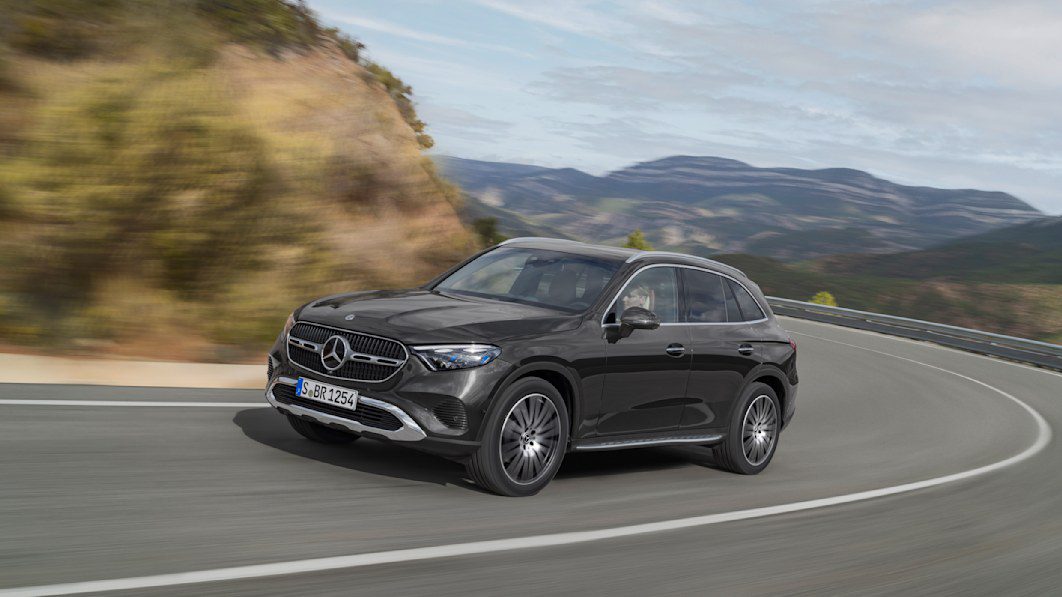2023 Mercedes-Benz GLC-Class revealed as an evolutionary step forward

This is the redesigned 2023 Mercedes-Benz GLC 300, and it’s a vital redesign for Mercedes, because the GLC-Class is the company’s best-selling model. We’re seeing the new SUV in its base GLC 300 (rear-wheel drive model) and GLC 300 4Matic trims first, but Mercedes has already told us that the usual follow-up models are coming. Expect a plug-in hybrid (with a much bigger battery and far more electric range) to launch for 2024. Plus, AMG variants will be joining the fray later, too.
As for what’s new with the base GLC 300, there’s a lot to get to. As vehicles tend to do these days, this GLC generation is bigger than the last. Overall length is up 2.4 inches, and the wheelbase stretches by 0.59 inch. Front track width is up 0.24 inch, and rear track width is up by 0.91 inch — however, overall width remains the same. Mercedes says the size increase benefits rear cargo capacity, as it’s up by 1.8 cubic-feet versus its predecessor (which had more space than its numbers indicated). Rear legroom is generally static, seeing a 0.1 inch increase.
The exterior design doesn’t rock the boat, but Mercedes said the changes it made emphasize the vehicle’s width more. For example, the headlights now stretch horizontally and connect to the grille. A new chrome underguard is stretched further to achieve the same effect. Plus, wider rear taillights are connected by a “handle” of sorts to give the rear a stretched look. The usual black plastic cladding is present if you want it, but opt for the AMG Line, and Mercedes paints those wheel arch liners in body color for the first time — you can see what that looks like in the white car pictured in the gallery.
If you’ve seen the interior for the new C-Class, then you’ve essentially seen the new GLC’s interior, too. The pair look remarkably similar in photos. A big, vertically-oriented 11.9-inch infotainment system sits in the middle and is canted toward the driver. Meanwhile, a wide 12.3-inch screen floats in the dash as an instrument cluster. It’s all running the latest version of MBUX software. Wide expanses of trim are splashed across the rest of the visible dashboard and air vents inspired by the engine nacelles of aircraft are positioned throughout.
As for what’s making the new GLC 300 go, a new 2.0-liter turbocharged engine with mild-hybrid assistance is the standard powertrain setup. It’s Mercedes’ latest 2.0-liter turbo, and it’s the same one as is found in the C-Class, featuring a new twin-scroll turbocharger developed in collaboration with the Mercedes-AMG Formula 1 team. The 48-volt system uses an integrated starter generator (ISG) that supplies a boost at lower rpms. The new ISG improves start/stop smoothness and also facilitates “gliding” when possible, shutting the engine down at speed when it’s not necessary. Total system output is 258 horsepower and 295 pound-feet of torque — that’s 22 pound-feet of torque more than the previous GLC.
Shifting is handled by an updated nine-speed automatic transmission. It’s adapted for use with the new ISG, as it houses the electric motor and power electronics in the transmission housing. The all-wheel-drive system is also updated, and the new front axle allows higher torque levels to be transferred forward. Underneath, the new GLC is sporting a new four-link front suspension design that promises better handling and comfort. There is no air suspension option for this generation GLC 300 (it definitely wasn’t a popular option before), so it’s a passive-only suspension system. However, the 4Matic version features an off-road driving mode, downhill speed regulation and Mercedes’ “transparent hood” technology that allows you to “see” the ground directly underneath the hood via camera. European-spec GLC models gain the option of rear-wheel steering that is able to turn the rear wheels up to 4.5 degrees, but Mercedes isn’t making it an option in the United States, citing lack of demand in this size of vehicle.

Efficiency and noise comfort both improve thanks to a better coefficient of drag — it’s been reduced from 0.31 to 0.29 for the new GLC. Every area of the car has been scrutinized for better noise comfort in the cabin. Mercedes says that it’s used learnings and tech from the latest S-Class to help improve the GLC. As one specific example of innovation, Mercedes moved the side mirrors to the door panel, which it says is a more favorable position for wind noise and aero.
Of course, the new GLC is loaded with driver assistance systems. Improvements from the previous generation are numerous. The “Active Distance Assist” can now detect and react to stationary objects at speeds up to 60 mph now (up from 35 mph). The “Active Steering Assist” features better lane detection, better cornering performance on backroads (off the highway), better operation at low speeds and improved centering on the highway. Plus, the traffic sign assist system can now rear signs posted overhead in addition to standard roadside signs. To help you see better at night, Mercedes’ Digital Light headlight tech is available as an option, though its full capabilities are still unclear with respect to U.S. headlight regulations.
Pricing is still unavailable for the new GLC, but expect the new SUV to arrive for the 2023 model year. When it does go on sale, Mercedes says it will adopt the new company strategy of offering various trims with differing levels of equipment, therefore greatly reducing the number of individual options you can select or not select. Of course, you’ll still be able to customize the usual exterior color, wheel option, interior upholstery and trim.
Related video:



